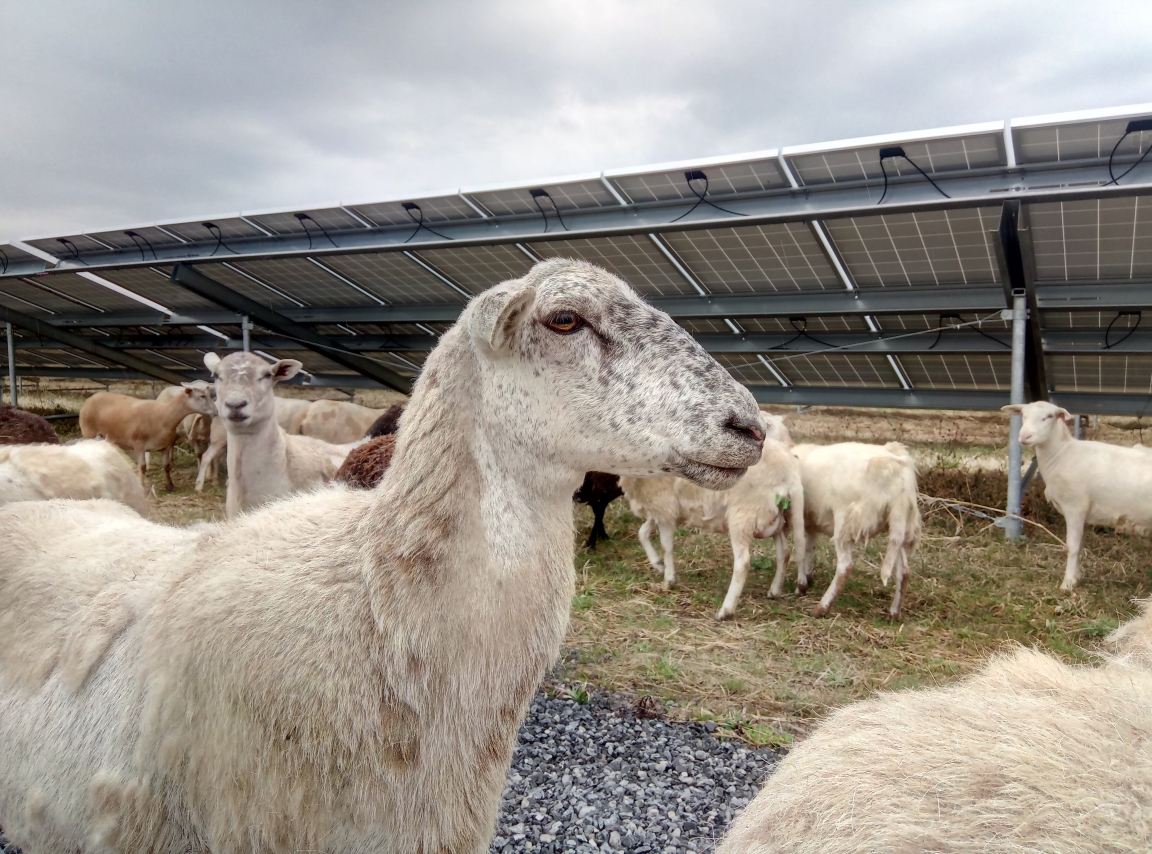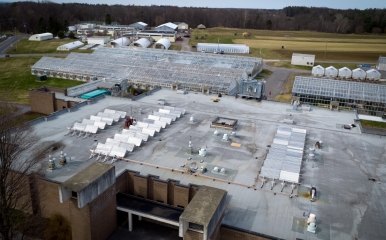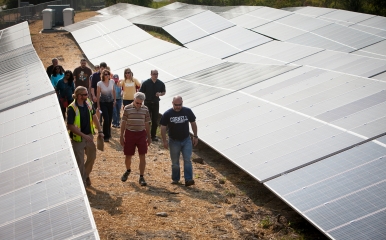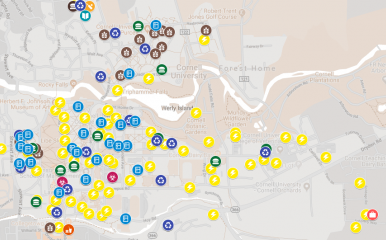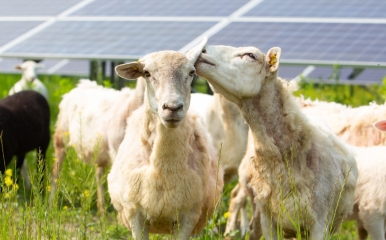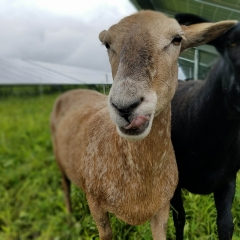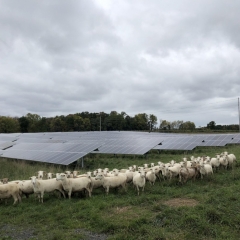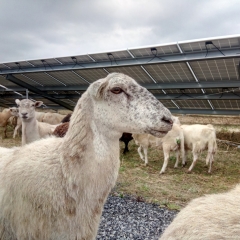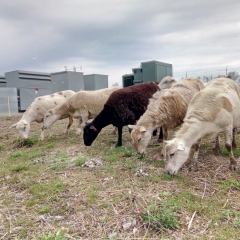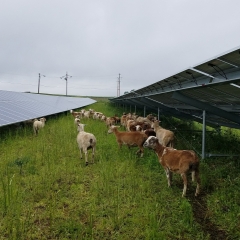Solar Renewable Energy
Cornell is striving to powering the campus with 100% renewable energy by 2035 as part of our commitment to carbon neutrality. We develop renewable energy resources that benefit our campus, community, and New York State, with an emphasis on large-scale solar farms and community solar projects.
About our Solar Energy Projects
Cornell has completed 15 solar energy projects to date. The University has six solar farms, seven on-campus arrays across eleven buildings, and three solar heating projects - as well as a mobile solar trailer used by the Grounds Department for fossil-fuel free, electric landscaping equipment.
Over 20% of campus electricity needs are met by our solar projects, though renewable production regularly meets 100% of campus demand on sunny, high-producing days year-round.
Additional solar projects and other renewable energy investments such as our campus hydropower plant could help the campus meet 100% of our year-round demand by the end of the early 2020s.
Cornell works with the Regional Greenhouse Gas Initiative (RGGI) - a carbon cap and trade program for utility-scale power generators in 11 states in the Northeast and mid-Atlantic, to displace fossil fuel generation equivalent to our solar farm generation. Since nearly all the big fossil fuel plants in NY state are located in or adjacent to disadvantaged communities, this program is an environmental justice-aligned solution.
Recent News
Cornell approaches 100% renewable power years ahead of its goal September 15, 2023 Campus Sustainability Office
New residence halls save energy with eco-friendly features September 22, 2021 Cornell Chronicle
Sustainability efforts shine with new solar collectors April 02, 2021 Cornell Chronicle
Students seize sun’s blaze to wring out its power in contest June 03, 2020 Cornell Daily Sun
New Cascadilla Solar Farm Sustainability Powers 20% of Cornell University’s Annual Electricity Usage April 15, 2020 Cornell Daily Sun
Renewable energy covers 100% of Cornell’s power use for the first time over 100 years April 10, 2020 Campus Sustainability Office
Solar Projects at Cornell
Cornell has chosen to demonstrate leadership in solar energy development in New York State. We were the first Ivy and one of the first fifty campuses in the nation to undertake the ambitious goal to reach carbon neutrality for campus operations by 2035. We are committed to working with our community, county, and New York State on shared climate and renewable energy goals.
+20% annual
campus electricity needs are
met by our solar farms
15 solar projects
produce clean,
renewable energy
9 buildings
on campus have solar
power or heat systems
Co-Benficial Development: Solar development on our campus and in our state helps create a shared fossil-fuel-free grid, and by creating new, renewable energy resources we are helping New York State and Tompkins County reach our common goals for a climate-resilient and green energy future. Our solar farms are all in New York State, and have helped keep jobs and resources local. Finally, these resources act as powerful living laboratory spaces for testing new sustainability solutions - like creating a solar grazing program for New York State farmers - and offer teaching space for students and local K12 schools.
On-Campus Solar Projects
9 projects for energy and heat
Jump to see details by project
Solar Arrays & Projects
(2007) Cornell Campus Store Solar Array
(2012) Human Ecology Solar Array
(2014) Fernow Hall Solar Skylight
(2014) Snee Hall Solar Array
(2015) Klarman Hall Solar Array
(2021) North Campus Housing (Phase 1)
Solar Heating
(2011) Central Energy Plant Solar Heating
(2012) Cornell Botanic Gardens Nevin Welcome Center Solar Heating
Solar Farms
6 projects producing 28MW
Jump to see details by project
(2014) Snyder Road Solar Farm, Lansing NY
(2015) Sutton Road Solar Farm, New York State Agricultural Experiment Station, Geneva NY
(2016) Cornell Ruminant Center Solar Farm, Cornell University Ruminant Center, Harford NY
(2016) Musgrave East and Musgrave West Solar Farms, Cornell Agricultural Experiment Station, Ledyard NY
(2019) Cascadilla Community Solar Farm, Dryden NY
Other Projects
Cornell Grounds Department Solar Trailer
Projected 2022: North Campus Housing Solar Phase 2
Projected: New York Large Scale Renewable Energy Project (NYLSRE)
Research Resources for Students and Faculty
Explore solar production by on-campus and off-campus arrays, including data views for daily, monthly, or year-to-year comparison.
Should we develop solar arrays on-campus? Read Cornell's in-depth analysis performed as a living laboratory project by students & staff.
Interested in visiting with a class, performing research, or bringing a community group to a solar farm?
Where are our solar farms and on-campus projects? Find them on the Sustainability Map
Research on using sheep for grounds maintenance of solar farms
Are you a student or faculty interested in research using Cornell's solar projects?
Contact the Campus Sustainability Office for support.
sustainability@cornell.edu
Expand each section to learn more specific projects and the history of our solar farm development on Cornell-owned land in New York State. Our solar farms produce 28MWac, or 40MWdc.
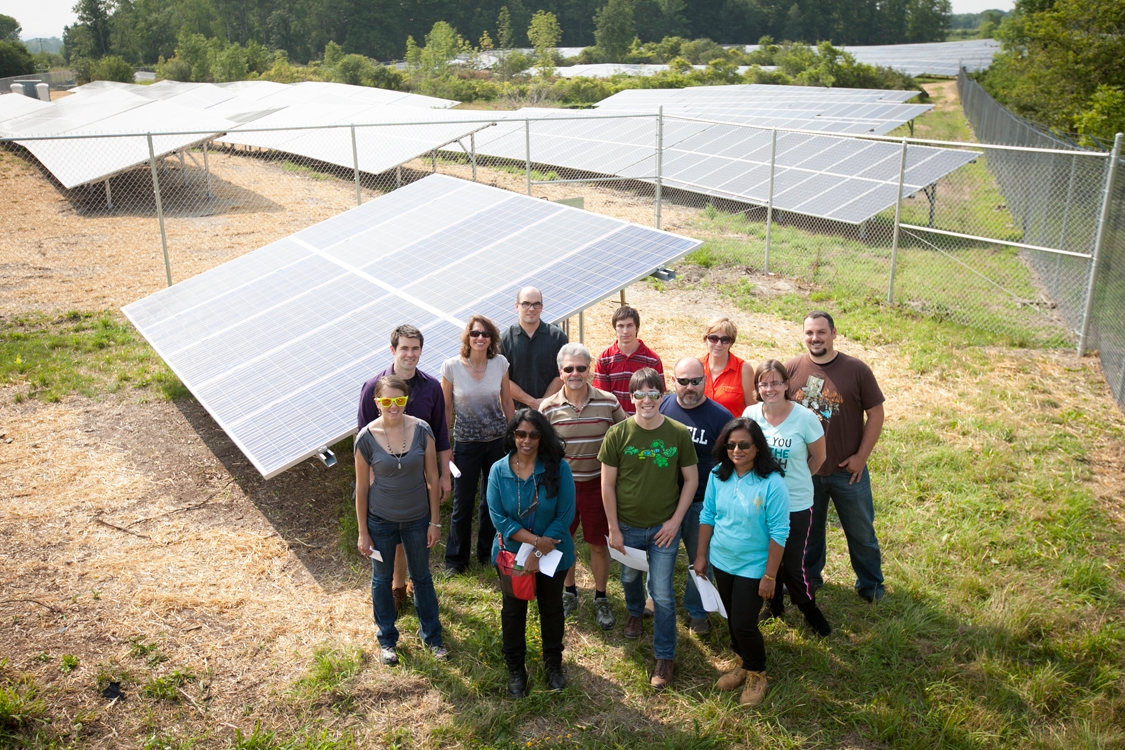
Snyder Road Solar Farm (2014)
Lansing NY
Cornell’s first solar farm, Snyder Road Solar Farm was the first megawatt-scale renewable energy generation project undertaken by the campus since the hydropower plant came online in 1904. Snyder Road was the first of Cornell’s solar farms to pilot using sheep to mow the grass and was developed on land with limited development potential. The facility has a 30 year PPA and generates renewable energy credits (RECs).
Research at this Site
A special 10 panel educational section was constructed for students and faculty to physically experiment with solar energy. The living lab solar area is separately metered, separately fenced and has a tilt rack system to allows researchers to show changes in solar output by tweaking the positioning of a small portion of the solar panels.
Other Research: Hydrology impacts; small mammals and predation
Special Project Features
The solar facility is sited on lands with limited development potential. Historic operations on nearby land left soil and groundwater compromised and unfit for redevelopment. By building solar at the property, Cornell restored undesirable property – located at the end of an airport runway - to productive use.
The solar farm layout was designed to avoid, and protect, wetlands on the property. The final design integrates the wetlands in the center of the arrays, allowing for both ecological habitat and renewable energy production.
Project Details
-
Date Online: 2014
-
Size: 2MW / 2.5 million KWH annual production on 11 acres of land
-
Cornell Impact: Provides about 1% of Cornell’s annual electricity needs. 450 MTCO2e / year carbon reduction, about .2% of campus carbon footprint
News & Resources
-
09.22.14 Cornell Flips the Switch at Snyder Road Solar Farm (Cornell Daily Sun)
-
07.29.14 Cornell solar farm ready to generate (Ithaca Journal)
-
12.18.17 Snyder Road Solar Farm Gets Visitors from Middle School (Campus Sustainability Office)
-
Designing a Solar Energy Field: Snyder Road Solar Farm at Cornell (Video)
-
Going Live | Middle School Visitors | Ithaca Journal | More Photo & Videos
Sutton Road Solar Farm (2016)
New York State Agricultural Experiment Station, Geneva NY
Cornell’s second solar farm, Sutton Road Solar Farm in Geneva, NY provides 40% of the annual electricity demand for the New York State Agricultural Experiment Station located there. Solar sheep are used to mow the grass. The facility has a 30 year PPA and generates renewable energy credits (RECs) - the estimated RECs value in the first year of production was approximately $3,400.
Research at this Site
Using the sheep at the solar farm-inspired grape researcher on the adjacent plot to try using dwarf sheep to maintain vegetation around the vines instead of herbicides.
Project Details
-
Date Online: 2016
-
Size: 2MW / 3.2 million KWH annual production on 13 acres of land
-
Cornell Impact: Provides about 40% of the Experiment station's electricity needs annually
News & Resources
Cornell Ruminant Center Solar Farm (2016)
Cornell University Ruminant Center, Harford NY
Completed in 2016, the Cornell Ruminant Center Solar Farm located in Harford NY uses solar sheep to mow the grass and was designed for more energy to be captured in the “shoulder production” periods, early morning and late evening, than in previous solar farm projects. By allowing for capture in a greater range of solar production, Cornell is able to stay within the regulatory limits and gain further solar energy returns for the array. The project was designed to allow a popular snowmobile trail to continue running adjacent to the solar farm. The facility has a 30 year PPA and generates renewable energy credits (RECs).
Project Details
-
Date Online: 2016
-
Size: 2MW / 3.3 million KWH annual production on 13 acres of land
-
Cornell Impact: Provides about 1.5% of Cornell's annual electricity needs
News & Resources
Musgrave East & Musgrave West Solar Farms (2016)
Cornell Agricultural Experiment Station, Ledyard NY
Musgrave East and Musgrave West Solar Farms (located at the Cornell Agricultural Experiment Station but developed as two separate projects to maximize energy production potential). The projects have a 30 year PPAs and generate renewable energy credits (RECs).
Research at this Site
An ongoing study on the “agricultural, economic and environmental potential of co-locating utility scale solar with grazing sheep” was undertaken by Nikola Kochendoerfer – Cornell University, Animal Science Department Lexie Hain – Agrivoltaic Solutions LLC & American Solar Grazing Association Michael L. Thonney – Cornell University, Animal Science Department. The aim of this study was to compare economic and agricultural benefits and challenges of traditional land management strategies (mowing, string trimming) with rotationally grazed sheep on solar sites.
Project Details
Date Online: 2016
Size: 4MW / 6.6 KWH annual production on 28 acres of land, combined (two 2MW solar farms producing 3.3 KWH annual each)
Cornell Impact: Provides about 3% of Cornell's annual electricity needs
News & Resources
- Facilities & Campus Services Project Overview
- 12.31.2015 Cornell University works with developers on five 2-MW solar projects (TransmissionHub)
Cascadilla Community Solar Farm (2019)
Dryden NY
The Cascadilla Community Solar Farm located on Cornell-owned lands in Dryden, NY allowed the University to lease non-producing farmland to a solar developer who provides solar power to local families in surrounding communities. Cornell claims the RECs or ‘renewable energy credits’ from the project as part of the climate action plan goal to reach carbon neutrality by 2035. The project serves over 3,000 families in upstate New York. The project was more than quadruple the size of any previous solar project undertaken by the University. Eight arrays are grouped on three subsites.
Research at this Site
Grazing Sheep on Solar Array Sites to Boost Pollinator Habitat and Sequester Soil Carbon (2019)
Special Project Features
Cascadilla Community Solar Farm is the largest community solar farm operating in upstate New York, as of the early 2020s. Community solar farms are a smart and socially just method of renewable energy development, as a way to make renewable energy accessible to everyone. Customers benefit by avoiding high upfront costs and maintenance, and purchasing cheaper electricity.
Project Details
Date Online: 2019
Size: 18MW / 25 million KWH annual production on 125 acres of land
Cornell Impact: Provides about 13% of Cornell's annual electricity needs
News & Resources
03.06.19 New solar farm ‘extends art of the possible’(Cornell Chronicle)
02.10.20 Cascadilla Community Solar Farm at Cornell University connects to NYSEG grid (Campus Sustainability Office)
NY Large Scale Renewable Energy (LSRE)
Cornell is pursuing LSRE projects in New York state that will help the campus achieve it's 100% renewable electricity goal years ahead of schedule!
110MW Solar PV Project
This new solar photovoltaic project is expected to generate about 150,000 megawatt hours (MWh) every year. The planned 110-megawatt (MW) project in Batavia, NY – some 94 miles northwest of the Ithaca campus - seeks to be operational in 2027 using bifacial panels which capture energy when the sunlight hits both the front and the back, and solar tracking technology to maximize generation. Cornell and project developer Distributed Sun will collaborate to leverage new research on best practices for sustainable design and operation, and the completed array will continue to serve as a living laboratory supporting Cornell’s research, academic and public engagement mission.
Solar energy can be harnessed for power or heating campus buildings and has been used as part of many campus buildings' LEED certification design process.
Cornell Campus Store Loading Dock (2007)
The Cornell Store system was installed concurrent with the Day Hall array in late 2006, early 2007. The array produces about 1,500 to 1,800 kilowatt hours, worth about $150 to $180 a year when the system was installed.
-
Panels: 8
-
Production Power: 2.2 kW
-
% of building’s electricity: 0.2%

College of Human Ecology (2015)
The Human Ecology Building’s rooftop solar project was developed in 2015 by Distributed Sun in partnership with the Colleges of Arts and Sciences, the College of Human Ecology, Cornell Energy and Sustainability, and Building Energy. The Human Ecology Building was the first building on campus that achieved LEED® Platinum. This is the largest rooftop array on campus, as of 2020.
-
Panels: 228
-
Production Power: 76 kW
-
% of building’s electricity: 6%

Fernow Hall (2014)
Fernow Hall's rooftop solar project features PV skylights and traditional PV panels. Typically, skylights require some shading to block sunlight during the most intense periods of the day, but solar integrated glass provides a dual benefit by blocking glare, reducing cooling loads, and producing renewable energy.
-
Panels: 2 panels and 5 pyramid-shaped skylights with PV cells
-
Production Power: 2.2 kW
-
% of building’s electricity: 1%

Snee Hall (2014)
Snee Hall's rooftop solar array was developed in 2014 by Cornell University Sustainable Design (CUSD) student group.
-
Panels: 18
-
Production Power: 3.5 kW
-
% of building’s electricity: %

Klarman Hall (2015)
Klarman Hall’s rooftop solar project was developed in 2015 by Distributed Sun in partnership with Cornell Energy Sustainability and the Colleges of Arts and Sciences. Klarman Hall is a LEED Certified Platinum green building due to its array of sustainable features, including a rainwater reclamation system, living green roof areas, and light wells.
-
Panels: 64
-
Production Power: 20 kW
-
% of building’s electricity: 50%

A rooftop solar thermal system provides hot water for building heating and for shower/service water use, significantly reducing the amount of natural gas consumption.
Cornell has two solar heating systems in operation. The Central Energy Plant office and the Brain C. Nevin Welcome Welcome Center systems both use evacuated tube solar collectors, featuring glass tubes with black surface coating to absorb solar energy.
Central Energy Plant Solar Heating System (2011)
The 120,000 Btu/hr peak output on the roof provides the majority of the offices yearly domestic hot water heating needs as well as approximately 15% of the yearly building comfort heating needs.
This solar heating system was put into place as part of the building’s LEED Gold Certification and paired with energy efficiency upgrades.
Cornell Botanic Gardens Nevin Welcome Center Solar Heating System (2012)
A similar solar thermal system as the CEP, the Nevin Welcome Center’s LEED Gold Certified building has 65,000 Btu/hr peak output or approximately 10% of the yearly building comfort heating needs.

North Campus Residential Complex (2022)
From the rooftops of Cornell’s North Campus Residential Expansion (NCRE), the university will gather enough solar energy to offset about 1 megawatt of electricity annually (35% of the new building complex's electricity) and further reduce the university’s carbon footprint.
-
Production Power: 1.1 MW
-
% of NCRE electricity: 35%
News & Resources
Day Hall (2006-2022)
Day Hall’s rooftop solar project was developed in 2006 thanks to generous donations from the Krich Family Solar Fund and Cornell trustee emeritus Dick Aubrecht '66, Ph.D. '70. At the time, it was the third-largest solar array in Tompkins County. The solar panels were the first rooftop solar project on the Cornell campus, and generate enough electricity to light the clocktower! The Day Hall solar array was decommissioned in 202 when the panel inverters reached the end of their useful life.
-
Panels: 54
-
Production Power: 15 kW
The Day Hall panels produced over 630,000 kWh throughout their time in service. Over its 14-year lifetime, the system produced energy equivalent to 1,034 barrels of oil.

Solar Sheep Mowing
Cornell University has used its solar farms as living laboratory spaces to test, perfect, and create pilot materials for New York State farmers on co-beneficial use of sheep to maintain the grass and other materials in solar farms or large-scale arrays. Solar grazing is the use of livestock to maintain vegetation under solar panels. It is just one practice under the larger umbrella of “agrivoltaics”: combining agricultural and renewable energy production on the same piece of land. Utilizing sheep for site vegetation has resulted in “2.5 times fewer labor hours than mechanical and pesticide management on site.”
-
Cornell University staff helped found the American Solar Grazing Association
-
Grazing Sheep on Solar Array Sites to Boost Pollinator Habitat and Sequester Soil Carbon (2019)
Thank You to Our Partners
Development of our solar resources would not be possible without the support and partnership of our solar developers.
Cornell University's solar farms are developed on Cornell-owned land in partnership with Distributed Sun and Building Asset Management, LLC via power purchase agreements.

